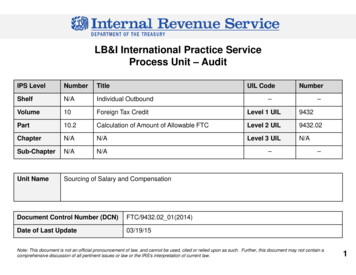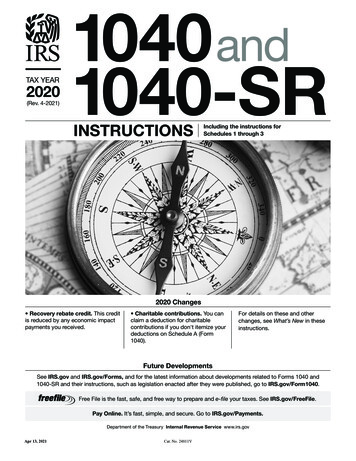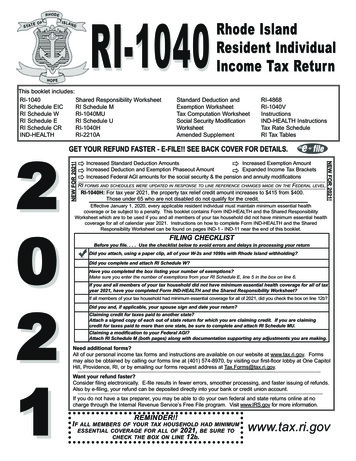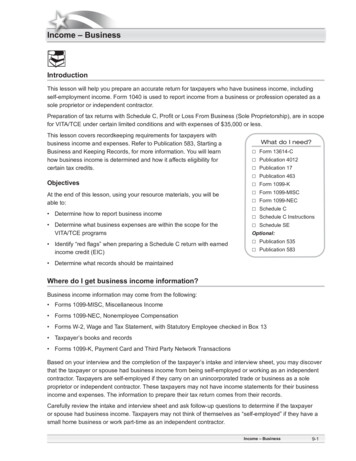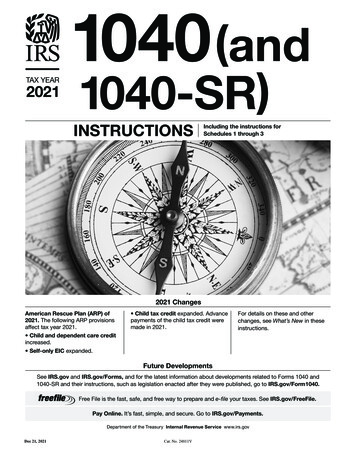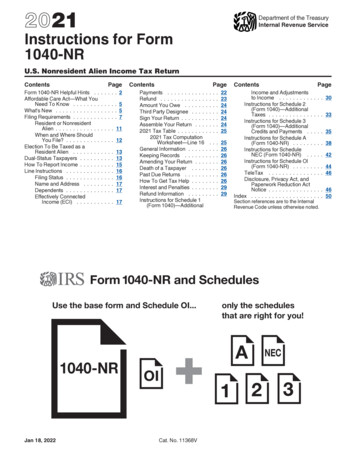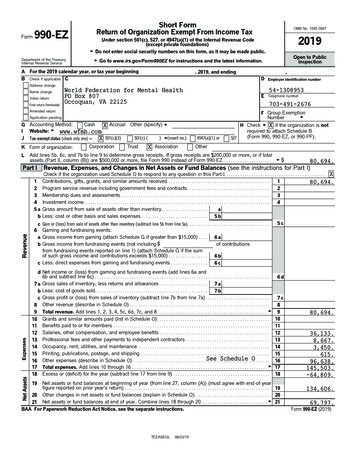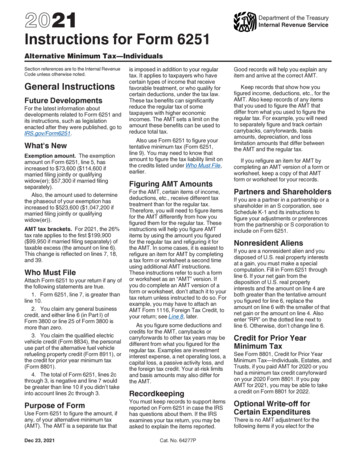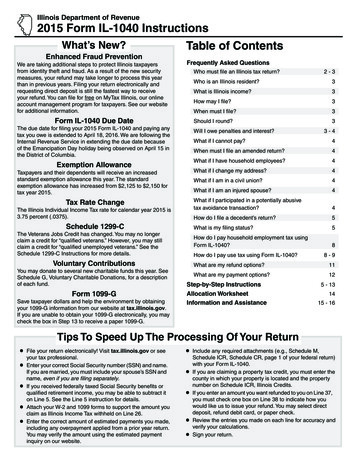
Transcription
Illinois Department of Revenue2015 Form IL-1040 InstructionsWhat’s New?Enhanced Fraud PreventionWe are taking additional steps to protect Illinois taxpayersfrom identity theft and fraud. As a result of the new securitymeasures, your refund may take longer to process this yearthan in previous years. Filing your return electronically andrequesting direct deposit is still the fastest way to receiveyour refund. You can file for free on MyTax Illinois, our onlineaccount management program for taxpayers. See our websitefor additional information.Form IL-1040 Due DateThe due date for filing your 2015 Form IL-1040 and paying anytax you owe is extended to April 18, 2016. We are following theInternal Revenue Service in extending the due date becauseof the Emancipation Day holiday being observed on April 15 inthe District of Columbia.Exemption AllowanceTaxpayers and their dependents will receive an increasedstandard exemption allowance this year. The standardexemption allowance has increased from 2,125 to 2,150 fortax year 2015.Tax Rate ChangeThe Illinois Individual Income Tax rate for calendar year 2015 is3.75 percent (.0375).Schedule 1299-CThe Veterans Jobs Credit has changed. You may no longerclaim a credit for “qualified veterans.” However, you may stillclaim a credit for “qualified unemployed veterans.” See theSchedule 1299-C Instructions for more details.Voluntary ContributionsYou may donate to several new charitable funds this year. SeeSchedule G, Voluntary Charitable Donations, for a descriptionof each fund.Form 1099-GSave taxpayer dollars and help the environment by obtainingyour 1099-G information from our website at tax.illinois.gov.If you are unable to obtain your 1099-G electronically, you maycheck the box in Step 13 to receive a paper 1099-G.Table of ContentsFrequently Asked QuestionsWho must file an Illinois tax return?2-3Who is an Illinois resident?3What is Illinois income?3How may I file?3When must I file?3Should I round?3Will I owe penalties and interest?3-4What if I cannot pay?4When must I file an amended return?4What if I have household employees?4What if I change my address?4What if I am in a civil union?4What if I am an injured spouse?4What if I participated in a potentially abusivetax avoidance transaction?4How do I file a decedent’s return?5What is my filing status?5How do I pay household employment tax usingForm IL-1040?8How do I pay use tax using Form IL-1040?8-9What are my refund options?11What are my payment options?12Step-by-Step InstructionsAllocation WorksheetInformation and Assistance5 - 131415 - 16Tips To Speed Up The Processing Of Your ReturnFile your return electronically! Visit tax.illinois.gov or seeyour tax professional.Enter your correct Social Security number (SSN) and name.If you are married, you must include your spouse’s SSN andname, even if you are filing separately.If you received federally taxed Social Security benefits orqualified retirement income, you may be able to subtract iton Line 5. See the Line 5 instruction for details.Attach your W-2 and 1099 forms to support the amount youclaim as Illinois Income Tax withheld on Line 26.Enter the correct amount of estimated payments you made,including any overpayment applied from a prior year return.You may verify the amount using the estimated paymentinquiry on our website.Include any required attachments (e.g., Schedule M,Schedule ICR, Schedule CR, page 1 of your federal return)with your Form IL-1040.If you are claiming a property tax credit, you must enter thecounty in which your property is located and the propertynumber on Schedule ICR, Illinois Credits.If you enter an amount you want refunded to you on Line 37,you must check one box on Line 38 to indicate how youwould like us to issue your refund. You may select directdeposit, refund debit card, or paper check.Review the entries you made on each line for accuracy andverify your calculations.Sign your return.
General InformationWho must filean Illinoistax return?If you werean Illinois resident, you must file Form IL-1040 ifyou were required to file a federal income tax return, oryou were not required to file a federal income tax return, but your Illinois base income from Line 9 isgreater than your Illinois exemption allowance.an Illinois resident who worked in Iowa, Kentucky, Michigan, or Wisconsin, you must fileForm IL-1040 and include as Illinois income any compensation you received from an employer in thesestates. Compensation paid to Illinois residents working in these states is taxed by Illinois. Based onreciprocal agreements between Illinois and these states, these states do not tax the compensation ofIllinois residents.If your employer in any of these states withheld that state’s tax from your compensation, you may file thecorrect form with that state to claim a refund. You may not use tax withheld by an employer for thesestates as a credit on your Illinois return.a retired Illinois resident who filed a federal return, you must file Form IL-1040. However, certaintypes of retirement income (e.g., pension, Social Security, railroad retirement, governmentaldeferred compensation) may be subtracted from your Illinois income. For more information, see theinstructions for Line 5 and Publication 120, Retirement Income.a part-year resident, you must file Form IL-1040 and Schedule NR, Nonresident and Part-YearResident Computation of Illinois Tax, ifyou earned income from any source while you were a resident,you earned income from Illinois sources while you were not a resident, oryou want a refund of any Illinois Income Tax withheld.a nonresident, you must file Form IL-1040 and Schedule NR ifyou earned enough taxable income from Illinois sources to have a tax liability (i.e., your Illinois baseincome from Schedule NR, Step 5, Line 46, is greater than your Illinois exemption allowance onSchedule NR, Step 5, Line 50), oryou want a refund of any Illinois Income Tax withheld in error. You must attach a letter of explanationfrom your employer.If you are a nonresident and your only income in Illinois is from one or more partnerships,S corporations, or trusts that withheld enough Illinois Income Tax to pay your liability, you are not requiredto file a Form IL-1040.an Iowa, Kentucky, Michigan, or Wisconsin resident who worked in Illinois, you mustfile Form IL-1040 and Schedule NR ifyou received income in Illinois from sources other than wages, salaries, tips, and commissions, oryou want a refund of any Illinois Income Tax withheld.If you received wages, salaries, tips, and commissions from Illinois employers, you are not required topay Illinois Income Tax on this income. This is based on reciprocal agreements between Illinois andthese states.The reciprocal agreements do not apply to any other income you might have received, such as Illinoislottery winnings.an Illinois resident who was claimed as a dependent on your parents’ or another person’sreturn, you must file Form IL-1040 ifyour Illinois base income from Line 9 is greater than 2,150, oryou want a refund of Illinois Income Tax withheld from your pay.If your parent reported your interest and dividend income through federal Form 8814, Parents’Election to Report Child’s Interest and Dividends, do not count that income in determining if you mustfile your own Form IL-1040.the surviving spouse or representative of a deceased taxpayer who was required to file inIllinois, you must file any return required of that taxpayer.a student, you are not exempt from tax nor are there special residency provisions for you. However,income, such as certain scholarships or fellowships, that is not taxable under federal income tax law, isalso not taxed by Illinois.a nonresident alien, you must file Form IL-1040 if your income is taxed under federal income tax law.You must attach a copy of your federal Form 1040NR, U.S. Nonresident Alien Income Tax Return, orfederal Form 1040NR-EZ, U.S. Income Tax Return for Certain Nonresident Aliens With No Dependents.2“Online Ontime”
General InformationEven if you are not required to file Form IL‑1040, you must file to get a refund ofIllinois Income Tax withheld from your pay,estimated tax payments you made, orwithholding on income passed through to you by a partnership, S Corporation, or trust.Who is anIllinoisresident?You are an Illinois resident if you were domiciled in Illinois for the entire tax year. Your domicile is the place whereyou reside and the place where you intend to return after temporary absences. Temporary absences may includeduty in the U.S. Armed Forces, residence in a foreign country, out-of-state residence as a student, or out-of-stateresidence during the winter or summer.If you filed a joint federal return and one spouse is an Illinois resident while the other spouse is anonresident or a part-year resident, you may file separate Illinois returns. If you file a joint Illinois return, you willboth be taxed as residents.What isIllinoisincome?Your Illinois income includes the adjusted gross income (AGI) amount figured on your federal return, plus anyadditional income that must be added to your AGI. Some of your income may be subtracted when figuring yourIllinois base income. For more information, see the Step-by-Step Instructions.You should follow the federal law concerning passive activity income and losses. You are not allowed to refigureyour federal passive activity losses.Also, federal law will govern the taxation of income from community property sources in the case of spouses whofile joint federal returns and who file separate Illinois returns.How mayI file?File your individual income tax return electronically by usingMyTax Illinois, available on our website for free,a tax professional, ortax preparation software.Almost all taxpayers can file electronically. Visit our website at tax.illinois.gov or see your tax professional. If youdo not wish to file electronically, you may use the paper Form IL-1040.When mustI file?Your Illinois filing period is the same as your federal filing period. We will assume that you are filing yourForm IL-1040 for calendar year 2015 unless you indicate a different filing period in the space provided at the top ofthe return. The due date for calendar year filers is April 18, 2016.We grant an automatic six-month extension of time to file your return. If you receive a federal extension of morethan six months, you are automatically allowed that extension for Illinois. These extensions do not grant you anextension of time to pay any tax you owe. If you determine that you will owe tax, you must use Form IL-505-I,Automatic Extension Payment for Individuals, to pay any tax you owe to avoid penalty and interest on tax not paidby April 18, 2016.Should Iround?You must round cents to whole dollars on Form IL-1040 and most schedules, as directed. To round you mustdrop amounts under 50 cents andincrease amounts of 50 to 99 cents to the next dollar.For example, 1.49 becomes 1 and 2.50 becomes 3.If you have to add two or more amounts to figure the amount to enter on a line, include cents when adding theamounts and round only the total.Will I owepenaltiesandinterest?tax.illinois.govYou will owea late-filing penalty if you do not file a return that we can process by the extended due date.a late-payment penalty for tax not paid by the original due date of the return.a late-payment penalty for underpayment of estimated tax if you were required to make estimated taxpayments and failed to pay the required amount by the payment due dates.a bad check penalty if your remittance is not honored by your financial institution.a cost of collection fee if you do not pay the amount you owe within 30 days of the date printed onany IDOR-2-BILL, Final Notice of Tax Due for Form IL-1040, Individual Income Tax Return, you receive.3
General Informationa frivolous return penalty if you file a return that does not contain information necessary to figure thecorrect tax or shows a substantially incorrect tax, because you are taking a frivolous position or are tryingto delay or interfere with collection of the tax.interest on unpaid tax from the day after the original due date of your return through the date you pay thetax.We will bill you for penalties and interest. For more information about penalties and interest, seePublication 103, Penalties and Interest for Illinois Taxes.What ifI cannotpay?If you cannot pay the tax you owe but you can complete your return on time, file your return by the duedate without the payment. This will prevent a late-filing penalty from being assessed. You will, however, owea late-payment penalty and interest on any tax you owe after the original due date, even if you have anextension of time to file.You have the option to pay the amount you owe electronically by using our website or by credit card. See theinstructions for Line 40.When mustI file anamendedreturn?Do not file another Form IL-1040 to make changes to a previously filed Form IL-1040. You must fileForm IL-1040-X, Amended Individual Income Tax Return, ifyou discover that you made an error on your Illinois return after it was filed, oryour federal return has been adjusted either by the Internal Revenue Service (IRS) or on a federalForm 1040X, Amended U.S. Individual Income Tax Return, you filed; the change affects your Illinoisincome, additions, subtractions, exemptions, or credits; and the change is final.If the federal change results in a refund, do not file Form IL-1040-X until you receive notificationthat your change has been accepted by the IRS.For more information, see Form IL-1040-X and instructions.What if I havehousehold employees?You may use Form IL-1040 to pay your household employees’ Illinois withholding. For more details on how topay withholding for your employees, see the instructions for Line 22.What if I change myaddress?If you change your address after you file, visit our website or call us to tell us your new address and the dateyou moved.What if I am in acivil union?If you are in a civil union, you must file your Illinois return using the same filing status as on your federalreturn.What if I am aninjured spouse?If you are married and you filed a joint federal return with your spouse and you are an injured spouse (e.g.,your spouse owes a liability, for which you are not responsible, to a government agency), you may elect to fileseparate Illinois returns using the “married filing separately” filing status. You may make this election up untilthe extended due date of your return, and once the election is made, it is irrevocable for the tax year.If you file a joint Illinois return, we may take the entire refund to pay your spouse’s liability.What if I participatedin a potentiallyabusive taxavoidancetransaction?4If you participated in a reportable transaction, including a “listed transaction,” during this tax year and wererequired to disclose that to the IRS, you are also required to disclose that information to Illinois.You must send us two copies of the form you used to disclose the transaction to the IRS. You mustattach one copy to your tax return, andmail a second copy to the Illinois Department of Revenue,P.O. Box 19029, Springfield, Illinois 62794-9029.Employee benefit plans and other subtractions allowed on Form IL-1040, Lines 5 through 7, arenot reportable transactions. For more information, contact the IRS or your tax professional.“Online Ontime”
Lines A-DStep 1Step-by-Step InstructionsPersonal InformationLine ASocial Security numberEnter your Social Security number (SSN) and your spouse’s SSN,even if you are married filing separate returns.If you do not qualify for a SSN and were issued an IndividualTaxpayer Identification Number (ITIN) by the IRS, enter your ITIN.Line BName and addressPrint your full name and address. If you are married and filing a jointreturn, print both names as they appear on your federal return. If youare married and filing separate returns, print your full name and yourspouse’s full name.Filing a decedent’s returnWhen you are filing a joint return as a surviving spouseprint your name and your spouse’s name on theappropriate lines.write “deceased” and the date of death above yourspouse’s name.sign your name in the area provided for your signature,and write “filing as surviving spouse” in place of thedecedent’s signature.If you, as the surviving spouse, are due a refund, the refundwill be issued directly to you. You are not required to completeForm IL-1310, Statement of Person Claiming Refund Due aDeceased Taxpayer.When you are filing a return on behalf of a single deceasedtaxpayerprint the name of the taxpayer on the appropriate line.write “deceased” and the date of death above thedecedent’s name.write “in care of,” and the executor’s name and address.A personal representative, such as an executor or administratormust sign and date the return. The representative’s title andtelephone number must be provided.Line CFiling statusIn general, you should use the same filing status as on your federalreturn. However,if you file a joint federal return and you are an injured spouse(e.g., your spouse owes a liability, for which you are notresponsible, to a government agency), you should file separateIllinois returns using the “married filing separately” filing status.Do not recompute any items on your federal return. Instead, youmust divide each item of income and deduction shown on yourjoint federal return between your separate Illinois returns followingthe Allocation Worksheet on Page 14.You may choose to file separately as an injured spouse only untilthe extended due date of the return, and once you choose afiling status the decision is irrevocable for the tax year.If you choose to file a joint Illinois return, we may takethe entire refund to pay your spouse’s liability.if you file a joint federal return and one spouse is a full-yearIllinois resident while the other is a part-year resident or anonresident (e.g., military personnel), you may choose tofile “married filing separately.” Do not recompute any items onyour federal return. Instead, you must divide each item of incomeand deduction shown on your joint federal return between yourseparate Illinois returns following the Allocation Worksheet onPage 14.If you choose to file a joint Illinois return, you must treat bothyour spouse and yourself as residents. This election isirrevocable for the tax year. You may be allowed a creditfor income tax paid to another state on Schedule CR. For moreinformation, see the Schedule CR instructions.If you are in a civil union, you must file your Illinois returnusing the same filing status as on your federal return.Line DMilitary veteransCheck the appropriate box if you or your spouse are a militaryveteran and you give the Illinois Department of Revenue permissionto share your name and address with the Illinois Department ofVeterans’ Affairs.If you are filing a return on behalf of a singledeceased taxpayer and a refund is due, attach Form IL-1310,Statement of Person Claiming Refund Due a Deceased Taxpayer.Foreign addressesEnter yourstreet address on the “Mailing address” line.apartment number, if applicable.city, province or state, and postal code on the “City, State,ZIP” lines in that order. Follow the country’s practice forentering the postal code.country name on the “Foreign Nation” line. Do notabbreviate the country name.tax.illinois.gov5
Lines 1-9Step 2IncomeLine 1Adjusted gross incomeEnter the adjusted gross income from your federal return. If youare not required to file a federal income tax return, use a federalForm 1040 as a worksheet to determine your adjusted gross income.Net operating loss (NOL)If you have a federal NOL this year, you may enter anegative amount on Line 1. However, you must reduce thatamount by any NOL that you carry back to prior years.If you deducted an NOL carryforward on your federal returnfor this year and some of that NOL remains available to carryforward to next year, the amount on Line 1 should be yourfederal adjusted gross income computed without deductingthe NOL carryforward, minus the amount of “Modified TaxableIncome” on Line 9 of the federal Worksheet for NOL Carryoverfound in Table 1 of IRS Publication 536, Net Operating Losses(NOLs) for Individuals, Estates, and Trusts.Line 2Federally tax-exempt incomeEnter the amount of federally tax-exempt interest and dividendincome reported on federal Form 1040, U.S. Individual Income TaxReturn, or federal Form 1040A, U.S. Individual Income Tax Return,Line 8b or to the left of federal Form 1040EZ, Income Tax Return forSingle and Joint Filers With No Dependents, Line 2.Step 3Base IncomeLine 5Social Security benefits and certain retirement plansEnter the amount of federally taxed Social Security and retirementincome included in your adjusted gross income on Form IL-1040,Line 1 that you received fromqualified employee benefit plans (including railroad retirementand 401(K) plans) reported on federal Form 1040, Line 16b, orForm 1040A, Line 12b.Individual Retirement Accounts or self-employed retirementplans reported on federal Form 1040, Line 15b, or Form 1040A,Line 11b.Social Security and railroad retirement benefits reported onfederal Form 1040, Line 20b, or Form 1040A, Line 14b.government retirement and government disability plansand group term life insurance premiums paid by a qualifiedretirement plan reported as wages on your federal Form 1040 or1040A, Line 7.state or local government deferred compensation plansreported on federal Form 1040, Line 7 or 16b, or Form 1040A,Line 7 or 12b.certain capital gains on employer securities reported on federalForm 1040, Line 13.certain retirement payments made directly to retired partnersreported on federal Form 1040, Line 17.Your beneficiary share of payments from certain retirementplans and retirement payments to retired partners reported on6Your distributive share of federally tax-exempt interest anddividend income received from a partnership, S corporation, trust, orestate is added back on Schedule M, Line 2.Line 3Other additionsComplete Schedule M if you have any of the following items:your child’s federally tax-exempt interest and dividend income asreported on federal Form 8814a distributive share of additions you received from a partnership,S corporation, trust, or estateLloyds plan of operations loss, if reported on your behalf on FormIL-1065, and included in your adjusted gross incomeearnings distributed from IRC Section 529 college savingsand tuition programs if these earnings are not included in youradjusted gross income, Line 1an addition amount calculated on Form IL-4562, SpecialDepreciationbusiness expense recapture (nonresidents only)recapture of deductions for contributions to Illinois collegesavings plans transferred to an out-of-state plancredit received on Schedule 1299-C for student-assistancecontributions made as an employer on behalf of your employeesdeductions claimed in prior years for college savings plancontributions if you made a nonqualified withdrawal this tax yearany other amounts that you are required to add to your federaladjusted gross incomeFor more information, see the Schedule M instructions.Schedule M and any required supporting documents.Schedule K-1-T should not be included on Line 5. For moreinformation, see the Schedule M instructions.For more information, see Publication 120.Federal Form 1040 or 1040A, Page 1 and any W-2 and1099 forms. If your retirement income is not reported on your federalForm 1040, Lines 15b, 16b, and 20b or Form 1040A, Lines 11b, 12b,and 14b or shown on your W-2 and 1099 forms, see Publication 120 fora list of any additional required attachments.Line 6Illinois Income Tax overpaymentEnter the total amount of any Illinois Income Tax overpayment(including any amount that was credited to another tax liability)reported as income on your 2015 federal Form 1040, Line 10. Do notinclude other states’ refunds on this line.If you filed a federal Form 1040A or Form 1040EZ, you maynot take this subtraction.Line 7Other subtractionsYou may be entitled to subtract other items from your income. Seethe instructions for Schedule M to see if you are eligible for othersubtractions.Schedule M and any required supporting documents.Line 9Base incomeThis line may not be less than zero. If the result is a negativenumber, enter “zero.”“Online Ontime”
Lines 10-19Step 4ExemptionsLine 10If you did not file a federal return, use the federal Form 1040as a worksheet, and enter the number of exemptions you would haveclaimed if you had filed one.Line 10bIllinois exemption allowanceLine 10aIf you filedfederal Form 1040 or 1040A, your number of exemptions is foundin box 6d of your federal return.federal Form 1040EZ, your number of exemptions is0 - if you are single and you checked the “You” boxon Line 5 of your federal return, or if you are marriedfiling jointly and you checked both the “You” and“Spouse” boxes on Line 5 of your federal return.1 - if you are single and did not check the “You” box onLine 5 of your federal return, or if you are married filingjointly and you checked only one box (either “You” or“Spouse”) on Line 5 of your federal return.2 - if you are married filing jointly and did not check eitherbox on Line 5 of your federal return.Step 5Net IncomeLine 11Illinois residents only – Net incomeThis line may not be less than zero. If the result is a negativenumber, enter “zero.”If someone else can claim you as a dependent and your Illinois baseincome (Form IL-1040, Line 9, or Schedule NR, Line 46) is 2,150 or less, your number of exemptions is 1.greater than 2,150, your number of exemptions is 0.If your Illinois base income is 4,300 or less, you are marriedfiling jointly, and both of you can be claimed as dependents onsomeone else’s return, your number of exemptions is 2.Line 10cIf you (or your spouse if married filing jointly) were 65 or older, checkthe appropriate box(es). Your number of exemptions is equal to thenumber of boxes checked.Line 10dIf you (or your spouse if married filing jointly) were legally blind, checkthe appropriate box(es). Your number of exemptions is equal to thenumber of boxes checked.Line 12Nonresidents and part-year residents only – Residencyand Illinois incomeFirst, check the box to identify whether you were a nonresident or apart-year resident of Illinois during 2015.Next, complete Schedule NR. Enter the amount from Schedule NR,Line 46, on Line 12. This line may not be less than zero.Schedule NR.Step 6TaxLine 13Tax amountIllinois residents: Follow the instructions on the form.Nonresidents and part-year residents only: Enter your tax fromSchedule NR, Line 52. This line may not be less than zero.Schedule NR.Step 7Tax After NonrefundableCreditsForm IL-1040, Line 16 Line 17 Line 18cannot be greater than Line 15.Line 16Income tax paid to another state – Illinois residents andpart-year residents onlyIf you were taxed by another state on income you received while youwere an Illinois resident, you may be entitled to this credit. See theSchedule CR instructions and Publication 111, Illinois Schedule CRfor Individuals, to see if you are eligible to take this credit.Schedule CR, Pages 1 through 3.tax.illinois.govLine 14Recapture of investment tax creditsIf you claimed an investment credit in a previous year, and theproperty considered in the computation of that investment credit wasdisqualified within 48 months after being placed in service, you mustcomplete Schedule 4255, Recapture of Investment Tax Credits, andenter the recapture amount on this line.Schedule 4255.Line 17Property tax and K-12 education expense creditYou may be entitled to credit for property tax and K-12 educationexpenses you paid. See the instructions for Schedule ICR to see ifyou are eligible for these credits.Schedule ICR and any required supporting documents.Line 18Credit from Schedule 1299-CYou may be entitled to credits from Schedule 1299-C. See theinstructions for Schedule 1299-C to determine if you are eligible forthese credits.Schedule 1299-C and any required supporting documents.Line 19Total nonrefundable payments and creditsAdd Lines 16, 17, and 18, and enter the total on Line 19.7
Lines 22-23Step 8When must I pay Illinois Use Tax to IDOR?Other TaxesLine 22Household employment taxEnter the amount of Illinois Income Tax you withheld from ahousehold employee. You may no longer use Form UI-WIT to reportIllinois Income Tax withheld from your household employee. SeePublication 121, Illinois Income Tax Withholding for HouseholdEmployees, for details on how to figure the amount to withhold andreport.Do not report household employee withholding here if youhave already reported or paid this amount using Form IL-941, IllinoisWithholding Income Tax Return, or Form IL-501, Payment Coupon.Line 23You must pay Illinois Use Tax to IDOR ifthe items you bought are taxable in Illinois,you used or consumed these items in Illinois, andwhen you purchased the items you eitherdid not pay any sales tax to the seller, orpaid sales tax at less than Illinois’ Use Tax rates of 6.25 percentfor general merchandise and 1 percent for food and drugs.For example, if you purchaseda computer over the internet for use in Illinois and paidno sales tax, you owe 6.25 percent Illinois Use Tax.jewelry while vacationing in Georgia upon which you paid4 percent sales tax and which you brought back toIllinois, you will owe Illinois Use Tax on the 2.25 percentdifference in tax rates.cheese by mail order from a company in Wisconsin andpaid no sales tax, you owe 1 percent Illinois Use Tax.How do I determine the Illinois Use Tax I owe?Use taxEnter the amount of Illinois Use Tax you owe. Use the Use Tax (UT)Worksheet or Use Tax (UT) Table to determine your use tax. Youmust make an entry on Line 23 (enter zero if you are not paying usetax on Form IL-1040).If you owe more than 600 in use tax ( 1,200 for married filingjointly taxpayers), you must file Form ST-44, Illinois Use Tax Return.You cannot change the amount of Illinois Use Tax you enteron Form IL-1040 by filing
The due date for filing your 2015 Form IL-1040 and paying any tax you owe is extended to April 18, 2016. We are following the Internal Revenue Service in extending the due date because of the Emancipation Day holiday being observed on April 15 in the District of Columbia.
